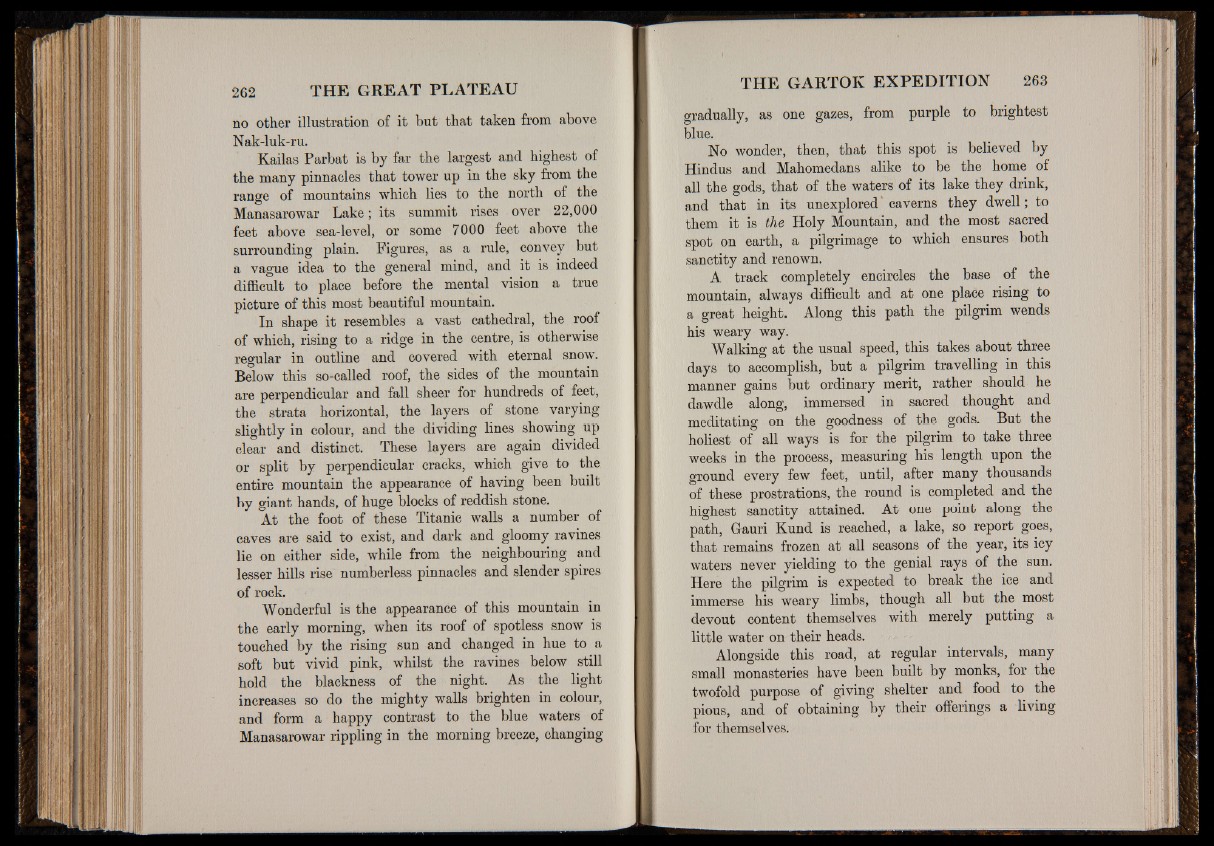
no other illustration of it but that taken from above
Nak-luk-ru.
Kailas Par bat is by far the largest and highest of
the many pinnacles that tower up in the sky from the
range of mountains which lies to the north of the
Manasarowar Lake; its summit rises over 22,000
feet above sea-level, or some 7000 feet above the
surrounding plain. Figures, as a rule, convey but
a vague idea to the general mind, and it is indeed
difficult to place before the mental vision a true
picture of this most beautiful mountain.
In shape it resembles a vast cathedral, the roof
of which, rising to a ridge in the centre, is otherwise
regular in outline and covered with eternal snow.
Below this so-called roof, the sides of the mountain
are perpendicular and fall sheer for hundreds of feet,
the strata horizontal, the layers of stone varying
slightly in colour, and the dividing lines showing up
clear and distinct. These layers are again divided
or split by perpendicular cracks, which give to the
entire mountain the appearance of having been built
by giant hands, of huge blocks of reddish stone.
At the foot of these Titanic walls a number of
caves are said to exist, and dark and gloomy ravines
lie on either side, while from the neighbouring and
lesser hills rise numberless pinnacles and slender spires
of rock.
Wonderful is the appearance of this mountain in
the early morning, when its roof of spotless snow is
touched by the rising sun and changed in hue to a
soft but vivid pink, whilst the ravines below still
hold the blackness of the night. As the light
increases so do the mighty walls brighten in colour,
and form a happy contrast to the blue waters of
Manasarowar rippling in the morning breeze, changing
gradually, as one gazes, from purple to brightest
blue.N
o wonder, then, that this spot is believed by
Hindus and Mahomedans alike to be the home of
all the gods, that of the waters of its lake they drink,
and that in its unexplored caverns they dwell; to
them it is the Holy Mountain, and the most sacred
spot on earth, a pilgrimage to which ensures both
sanctity and renown.
A track completely encircles the base of the
mountain, always difficult and at one place rising to
a great height. Along this path the pilgrim wends
his weary way.
Walking at the usual speed, this takes about three
days to accomplish, but a pilgrim travelling in this
manner gains but ordinary merit, rather should he
dawdle along, immersed in sacred thought and
meditating on the goodness of the gods. But the
holiest of all ways is for the pilgrim to take three
weeks in the process, measuring his length upon the
ground every few feet, until, after many thousands
of these prostrations, the round is completed and the
highest sanctity attained. At one point along the
path, Gauri Kund is reached, a lake, so report goes,
that remains frozen at all seasons of the year, its icy
waters never yielding to the genial rays of the sun.
Here the pilgrim is expected to break the ice and
immerse his weary limbs, though all but the most
devout content themselves with merely putting a
little water on their heads.
Alongside this road, at regular intervals, many
small monasteries have been built by monks, for the
twofold purpose of giving shelter and food to the
pious, and of obtaining by their offerings a living
for themselves.